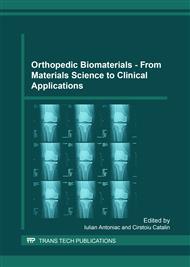[1]
K.C. Chung S.V. Spilson, The frequency and epidemiology of hand and forearm fractures in the United States, J Hand Surg 26A (2001) 908-915.
DOI: 10.1053/jhsu.2001.26322
Google Scholar
[2]
I. Antoniac, Biologically responsive biomaterials for tissue engineering, Springer, ISBN 978-1-4614-4327-8 (2013) 24-64.
Google Scholar
[3]
E.A. Ouellette, J.J. Dennis, E.L. Milne, L.L. Latta, A.L. Makowski, The role of soft tissues in plate fixation of proximal phalanx fractures. Clin Orthop Relat Res, 418 (2004) 213-218.
DOI: 10.1097/00003086-200401000-00036
Google Scholar
[4]
B. Sankar, V. Kamath, M. Macdonald, S.R. Murali, A simple and inexpensive splint for phalangeal fractures, Orthopaedics, 29(5), (2006) 407-409.
DOI: 10.3928/01477447-20060501-01
Google Scholar
[5]
AL Collins, M Timlin, B Thornes, T O'Sullivan, Old principles revisited - traction splinting for closed proximal phalangeal fractures, Injury 33(3), (2002) 235-237.
DOI: 10.1016/s0020-1383(01)00138-3
Google Scholar
[6]
T Ebinger, N Erhard, L Kinzl, M Mentzel, Dynamic treatment of displaced proximal phalangeal fractures, J Hand Surg (Am), 24(6), (1999) 1254-1262.
DOI: 10.1053/jhsu.1999.1254
Google Scholar
[7]
W.W. Lu, K. Furumachi, W.Y. Ip et. al. Fixation for comminuted phalangeal fractures. A biomechanical study of five methods, J Hand Surg 21B (1996) 765-767.
DOI: 10.1016/s0266-7681(96)80183-5
Google Scholar
[8]
G. Foucher, Bouquet, osteosynthesis in metacarpal neck fractures: A series of 66 patients. J Hand Surg. 20A (1995) S86-S90.
DOI: 10.1016/s0363-5023(95)80176-6
Google Scholar
[9]
J. Orbay, Intramedullary nailing of metacarpal shaft fractures, Tech Hand Up Extrem Surg. 9(2), (2005) 69-73.
DOI: 10.1097/01.bth.0000167253.31976.95
Google Scholar
[10]
A.A. Faraj, T.R. Davis, Percutaneous intramedullary fixation of metacarpal shaft fractures, J Hand Surg (Br). 24(1), (1999) 76-79.
DOI: 10.1016/s0266-7681(99)90039-6
Google Scholar
[11]
E. Dona, R.M. Gillies, M.P. Gianoutsos, W.R. Walsh, Plating of metacarpal fractures: unicortical or bicortical screws?, J Hand Surg (Br), 29(3), (2004) 218-221.
DOI: 10.1016/j.jhsb.2003.12.002
Google Scholar
[12]
J.J. Roth, D.M. Auerbach, Fixation of hand fractures with bicortical screws, J Hand Surg (Am) 30(1), (2005) 151-153.
DOI: 10.1016/j.jhsa.2004.07.016
Google Scholar
[13]
A.D. Soyer, Fractures of the base of the first metacarpal: current treatment options, J Am Acad Orthop Surg., 7(6), (1999) 403-412.
Google Scholar
[14]
E.J. Timmenga, T.J. Blokhuis, M. Maas et al., Long-term evaluation of Bennett's fracture: A comparison between open and closed reduction, J Hand Surg, 19B (1994) 373-377.
DOI: 10.1016/0266-7681(94)90093-0
Google Scholar
[15]
S.M. Page, P.J. Stern, Complications and range of motion following plate fixation of metacarpal and phalangeal fractures, J Hand Surg (Am) 23(5), (1998) 827-832.
DOI: 10.1016/s0363-5023(98)80157-3
Google Scholar
[16]
P. Kurzen, C. Fusetti, M. Bonaccio, L. Nagy, Complications after plate fixation of phalangeal fractures, J Trauma, 60(4), (2006) 841-843.
DOI: 10.1097/01.ta.0000214887.31745.c4
Google Scholar
[17]
A.E. Freeland, S.G. Lindley, Malunions of the finger metacarpals and phalanges, Hand Clin. 22(3), (2006) 341-355.
DOI: 10.1016/j.hcl.2006.03.001
Google Scholar
[18]
K.H. Liew, B.K. Chan, C.O. Low, Metacarpal and proximal phalangeal fractures - fixation with multiple intramedullary Kirschner wires, Hand Surg, 5(2), (2000) 125-130.
DOI: 10.1142/s0218810400000314
Google Scholar
[19]
C. McCarthy, J.B. Samora, H. Awan, Metacarpal shaft fractures: A review, OA Orthopaedics, 11(2), (2014) 2-12.
Google Scholar
[20]
J. Orbay, A. Touhami, The treatment of unstable metacarpal and phalangeal shaft fractures with flexible nonlocking and locking intramedullary nails. Hand Clin. 22 (2006) 279-286.
DOI: 10.1016/j.hcl.2006.02.017
Google Scholar
[21]
P.W. Berg, D. Ring, Patients lost to follow-up after metacarpal fractures, J Hand Surg Am. 37(1), (2012) 42-46.
DOI: 10.1016/j.jhsa.2011.08.003
Google Scholar
[22]
T. Petreus, B.A. Stoica, O. Petreus, A. Goriuc, C.E. Cotrut, I. Antoniac, L. Barbu-Tudoran, Preparation and cytocompatibility evaluation for hydrosoluble phosphorous acid-derivatized cellulose as tissue engineering scaffold material, Journal of Materials Science: Materials in Medicine, 25(4), (2014).
DOI: 10.1007/s10856-014-5146-z
Google Scholar
[23]
I. Antoniac, Biodegradability of some collagen sponges reinforced with different bioceramics, Key engineering materials, 32 (2014) 179-184.
DOI: 10.4028/www.scientific.net/kem.587.179
Google Scholar
[24]
I. Cristescu, D. Zamfirescu, D. Vilcioiu, et al., Experimental evaluation on rat model of different bioresorbable materials potentially used as orthopedic biomaterials. Key Engineering Materials, 614 (2014) 196-199.
DOI: 10.4028/www.scientific.net/kem.614.196
Google Scholar
[25]
F. Miculescu, D. Bojin, L.T. Ciocan, I. Antoniac, M. Miculescu, N. Miculescu, Experimental researches on biomaterial-tissue interface interactions, Journal of Optoelectronics and Advanced Materials 9(11), (2007) 3303 – 3306.
DOI: 10.4028/www.scientific.net/kem.638.14
Google Scholar
[26]
S.H. Kozin, J.J. Thoder, G. Lieberman, Operative treatment of metacarpal and phalangeal shaft fractures, J Am Acad Orthop Surg, 8(2), (2000) 111-121.
DOI: 10.5435/00124635-200003000-00005
Google Scholar
[27]
A.S. Paul, N. Kurdy, P.R. Kay, Fixation of closed metacarpal shaft fractures. Transverse K-wires in 22 cases., Acta Orthop Scand, 65(4), (1994) 427- 429.
DOI: 10.3109/17453679408995485
Google Scholar
[28]
J. Lieber, B. Harter, E. Schmid, H.J. Kirschner, P.P. Schmittenbecher, Elastic stable intramedullary nailing (ESIN) of pediatric metacarpal fractures: experiences with 66 cases, Eur J Pediatr Surg., 22(4), (2012) 305-310.
DOI: 10.1055/s-0032-1313339
Google Scholar
[29]
P.E. Blazar, D. Leven, Intramedullary nail fixation for metacarpal fractures, Hand Clin, 26(3), (2010) 321-325.
DOI: 10.1016/j.hcl.2010.05.005
Google Scholar
[30]
A. Sahu, S.S. Gujral, S. Batra, S.P. Mills, M.S. Srinivasan, The current practice of the management of little finger metacarpal fractures-a review of the literature and results of a survey conducted among upper limb surgeons in the United Kingdom, Hand Surg. 17(1), (2012).
DOI: 10.1142/s0218810412500098
Google Scholar
[31]
A.E. Freeland, Hand Fractures: Repair, Reconstruction and Rehabilitation, New York, NY: Churchill Livingstone, (2000).
Google Scholar
[32]
P.C. La Stayo, K.M. Winters, M. Hardy, Fracture healing: bone healing, fracture management and current concepts related to the hand, J Hand Ther, 16 (2003) 81–93.
DOI: 10.1016/s0894-1130(03)80003-0
Google Scholar
[33]
A. Toemen, R. Midgley, Hand therapy management of metacarpal fractures: an evidence-based patient pathway. Hand Therapy 15 (2010) 87–93.
DOI: 10.1258/ht.2010.010018
Google Scholar


